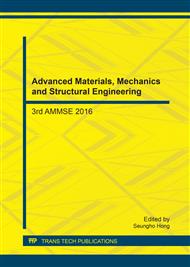p.89
p.93
p.102
p.107
p.112
p.117
p.123
p.129
p.135
Effect of Strain Rate on Tension Response of Filled Silicone Rubber
Abstract:
Uniaxial tension tests for filled silicone rubber were performed at high strain rates using a split Hopkinson tension bar system. Quasi-static tension tests were carried out using an Instron-E3000 material test system. The grip fixture was designed to reliably connect the tensile specimen with the incident/transmitted bars. The method to increase the signal-noise ratio of the stress pulse in the transmitted bar was proposed. The effect of specimen gage length-to-width ratio on the stress-strain responses was experimentally studied. The suitable specimen geometry was determined by means of experimental investigation and finite element analysis. The automated grid method was used to capture the deformation information of the tensile specimen. Experiments indicate that the tension responses of silicone rubber exhibit the apparent hyper-elastic and rate-dependent characteristics. The values of tensile modulus increase with the increase of strain rate. The stress at a given elongation increases with the increase of strain rate.
Info:
Periodical:
Pages:
112-116
Citation:
Online since:
February 2017
Authors:
Keywords:
Price:
Сopyright:
© 2017 Trans Tech Publications Ltd. All Rights Reserved
Share:
Citation:


